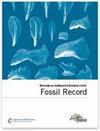下载PDF
{"title":"Mass concentration of Hirnantian cephalopods from the Siljan District, Sweden; taxonomy, palaeoecology and palaeobiogeographic relationships","authors":"Björn Kröger, Jan Ove R. Ebbestad, Annette E. S. Högström, Åsa M. Frisk","doi":"10.1002/mmng.201000014","DOIUrl":null,"url":null,"abstract":"<p>The Hirnantian Glisstjärn Formation (<i>Normalograptus persculptus</i> graptolite Biozone) is a succession of limestones and shales onlapping the Katian Boda Limestone in the Siljan District, Sweden. It contains a conspicuous, up to several decimeter thick bed densely packed with bipolarly oriented, orthoconic cephalopod conchs that can reach lengths of more than 120 cm. Conch fragmentation, bioereosion and the generally poor preservation of the conchs indicate time averaging and the conchs are tentatively interpreted as beached, and a result of winnowing. Ten nautiloid species were collected from the Glisstjärn Formation of which five are new: <i>Dawsonoceras gregarium</i> n. sp., <i>Discoceras siljanense</i> n. sp., <i>Isorthoceras dalecarlense</i> n. sp., <i>Retizitteloceras rarum</i> gen. et sp. n., and <i>Transorthoceras osmundsbergense</i> gen. et sp. n. The non-endemic taxa in most cases are known from elsewhere in Baltoscandia, except one species which is known from Siberia, and North America respectively. Proteocerid orthoceridans dominate the association, of which <i>T. osmundsbergense</i> is the predominant species. Oncocerids are diverse but together with tarphycerids very rare. Notable is the lack of many higher taxa, that are typical for other Late Ordovician shallow water depositional settings. Based on the taxonomical composition of the cephalopod mass occurrence it is interpreted as an indicator of eutrophication of the water masses in the area. (© 2011 WILEY-VCH Verlag GmbH & Co. KGaA, Weinheim)</p>","PeriodicalId":55147,"journal":{"name":"Fossil Record","volume":"14 1","pages":"35-53"},"PeriodicalIF":1.4000,"publicationDate":"2011-02-22","publicationTypes":"Journal Article","fieldsOfStudy":null,"isOpenAccess":false,"openAccessPdf":"https://sci-hub-pdf.com/10.1002/mmng.201000014","citationCount":"11","resultStr":null,"platform":"Semanticscholar","paperid":null,"PeriodicalName":"Fossil Record","FirstCategoryId":"89","ListUrlMain":"https://onlinelibrary.wiley.com/doi/10.1002/mmng.201000014","RegionNum":4,"RegionCategory":"地球科学","ArticlePicture":[],"TitleCN":null,"AbstractTextCN":null,"PMCID":null,"EPubDate":"","PubModel":"","JCR":"Q3","JCRName":"Earth and Planetary Sciences","Score":null,"Total":0}
引用次数: 11
引用
批量引用
Abstract
The Hirnantian Glisstjärn Formation (Normalograptus persculptus graptolite Biozone) is a succession of limestones and shales onlapping the Katian Boda Limestone in the Siljan District, Sweden. It contains a conspicuous, up to several decimeter thick bed densely packed with bipolarly oriented, orthoconic cephalopod conchs that can reach lengths of more than 120 cm. Conch fragmentation, bioereosion and the generally poor preservation of the conchs indicate time averaging and the conchs are tentatively interpreted as beached, and a result of winnowing. Ten nautiloid species were collected from the Glisstjärn Formation of which five are new: Dawsonoceras gregarium n. sp., Discoceras siljanense n. sp., Isorthoceras dalecarlense n. sp., Retizitteloceras rarum gen. et sp. n., and Transorthoceras osmundsbergense gen. et sp. n. The non-endemic taxa in most cases are known from elsewhere in Baltoscandia, except one species which is known from Siberia, and North America respectively. Proteocerid orthoceridans dominate the association, of which T. osmundsbergense is the predominant species. Oncocerids are diverse but together with tarphycerids very rare. Notable is the lack of many higher taxa, that are typical for other Late Ordovician shallow water depositional settings. Based on the taxonomical composition of the cephalopod mass occurrence it is interpreted as an indicator of eutrophication of the water masses in the area. (© 2011 WILEY-VCH Verlag GmbH & Co. KGaA, Weinheim)
瑞典Siljan地区Hirnantian头足类动物的质量浓度分类学、古生态学和古生物地理关系
Hirnantian Glisstjärn组(Normalograptus persculptus graptolite Biozone)是位于瑞典Siljan地区Katian Boda石灰岩上的一系列石灰岩和页岩。它有一个明显的,可达几厘米厚的床,密集地排列着双极定向的正圆锥头足类海螺,长度可达120厘米以上。海螺破碎、生物侵蚀和普遍保存不良表明时间平均,海螺暂时被解释为搁浅,是筛选的结果。在Glisstjärn组共收集到10种鹦鹉螺,其中5种为新种:Dawsonoceras gregarium n. sp.、Discoceras siljanense n. sp.、Isorthoceras dalecarlense n.、Retizitteloceras rarum gen. et sp.和Transorthoceras osmundsbergense gen. et sp.。除西伯利亚和北美各有一种外,其余的非特有种都来自巴尔托scandia的其他地区。正角鲨类占主导地位,其中osmundsbergense为优势种。石尾虫种类繁多,但与石尾虫一起出现的非常罕见。值得注意的是缺乏许多高级分类群,这是其他晚奥陶世浅水沉积环境的典型特征。根据头足类群的分类学组成,可以解释为该地区水体富营养化的一个指标。(©2011 WILEY-VCH Verlag GmbH &KGaA公司,Weinheim)
本文章由计算机程序翻译,如有差异,请以英文原文为准。


